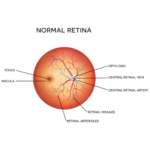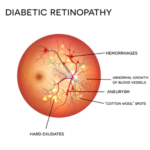Diabetic Retinopathy


What is Diabetic Retinopathy?
Diabetic retinopathy refers to a complication of diabetes that affects the blood vessels in your retina, the light-sensitive tissue at the back of your eye. If a patient has had diabetes for 20 years or more, chances are that you have signs of diabetic retinopathy. Diabetes affects the health of your blood vessels throughout your body, but the retina is one area where we can actually view the blood vessels and see disease and damage. With the advent of such sophisticated instrumentation such as an OCT (Optical Coherence Tomography) we can take non-invasive cross-section pictures of your retina and document areas of concern. We can follow changes from year to year and recommend treatment options when necessary.
The CDC notes that diabetic retinopathy can be found in about 33% of those with diabetes over 40. If you suspect you may have diabetic retinopathy, your initial awareness may include blurry vision. However, if diabetes remains unidentified or untreated and reaches late stages, it can damage the blood vessels in the retina, making it a leading cause of new cases of adult blindness.
Diabetics require regular eye exams, including a comprehensive dilated eye exam by a qualified eye doctor or optometrist. This ensures early detection because the earlier one begins managing diabetic retinopathy, the better the chances of avoiding significant vision issues like vision loss.
Types of Diabetic Retinopathy
1. Non-Proliferative Diabetic Retinopathy (NPDR): When detected early, patients can be asymptomatic. This is why an optometrist is required to notice if the blood vessels in the retina weaken or bulge in its early stages.
2. Proliferative Diabetic Retinopathy (PDR): As NPDR progresses, it becomes PDR in more advanced stages. This is the stage where damaged and weakened blood vessels cause new blood vessels to grow abnormally, leading to vision issues if left untreated.
Diabetic Retinopathy Symptoms
Although symptoms may vary, most people experience:
- Changing/blurry vision
- Floaters—dark spots/strings in your vision
- Impaired color vision
- Poor night vision
- A vision field with dark/empty areas
Diabetic Retinopathy Treatment Options
Available treatment options will depend on the stage and severity of the condition but must include maintaining strict levels of blood sugar to slow the disease. Other options may include:
- Laser Photocoagulation: Used to seal blood vessels that leak and reduce the growth of abnormal blood vessels.
- Intravitreal Injections: To reduce abnormal cell growth and leakage.
- Vitrectomy: Surgery may be needed in more severe cases.
Visit Jay K. Honda, O.D. for Diabetic Retinopathy Care
During our eye examination we screen and perform tests that allow for the early identification and treatment of diabetic retinopathy which is imperative for preserving your vision and avoiding future complications. If you or someone in your family has diabetes or there is a history of diabetes in your family, it is never too early to gather baseline data regarding your eye health. Let us be part of your health care journey. Do not let fear or procrastination prevent you from taking action. Call us today at 808-329-3535 to schedule an appointment. We will always be an advocate for your well being and health.
Location
Kailua-Kona, HI 96740
Contact
Fax: 888-504-0018
Hours
1:00-4:30pm
